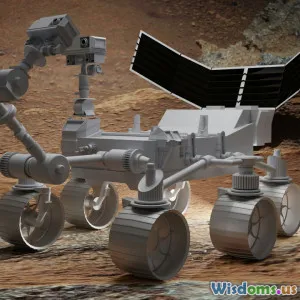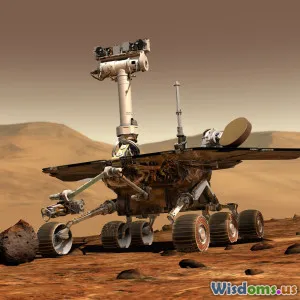
Humanity's Next Frontier: Colonizing Mars
9 min read Explore the challenges and possibilities of humanity's bold endeavor to colonize Mars. (0 Reviews)
Humanity's Next Frontier: Colonizing Mars
Introduction
For decades, Mars has captured the imagination of scientists, philosophers, and storytellers alike. The enigmatic Red Planet has been a fixture of science fiction, inspiring tales of adventure, survival, and human ingenuity. Today, what was once just fiction is rapidly transitioning into a tangible goal: colonizing Mars. But what does it really entail to establish a human presence 140 million miles away from Earth? As we stand on the cusp of becoming a multiplanetary species, this article explores the scientific breakthroughs, technological advancements, logistical hurdles, and philosophical questions that define humanity's next frontier.
The Allure of Mars
Mars has fascinated humanity for centuries, partly due to its relative proximity and surface conditions that, although harsh, are somewhat comparable to Earth’s. Unlike gas giants like Jupiter or Saturn, Mars is rocky and offers a solid surface. Its day is similar in length to Earth's (about 24.6 hours), and it shows polar ice caps along with evidence of ancient riverbeds, suggesting the planet once had liquid water.
This interest isn’t merely about exploration but survival. Visionaries like Elon Musk have publicly stated that establishing a colony on Mars is a way to ensure humanity's survival in the event of catastrophic events on Earth, such as nuclear war or asteroid impacts. Moreover, advancing space colonization pushes the boundaries of technology, fuel innovations, and inspires humanity globally.
Technological Challenges and Innovations
1. Transportation: Getting There and Back
Traveling to Mars is a logistical feat. The average distance between Earth and Mars varies between about 54.6 million kilometers to over 400 million kilometers depending on orbits. Current spacecraft take approximately 6–9 months to reach Mars using existing propulsion methods.
NASA’s Artemis program and SpaceX’s Starship are pioneering spacecraft systems intended to improve speed, cost-efficiency, and reliability. Starship, designed as a fully reusable vehicle, aims to ferry large numbers of people and cargo to Mars, significantly reducing costs compared to traditional rockets. However, challenges remain, such as radiation protection for astronauts during long voyages, microgravity’s effects on human physiology, and life support systems.
2. Life Support and Habitat
Mars’ atmosphere is 95% carbon dioxide and has less than 1% of Earth's atmospheric pressure, making it unbreathable. To survive, humans will need enclosed habitats providing oxygen, water, food, and temperature regulation.
NASA’s Mars oxygen ISRU experiment (MOXIE), which successfully produced oxygen from the Martian atmosphere on the Perseverance rover, illustrates a critical step toward sustaining life. Such in-situ resource utilization (ISRU) technologies reduce dependence on Earth supply missions. Greenhouses using Martian soil nutrients locked in perchlorates (toxic chemicals) present another research frontier, as experimenting with plant cultivation will be essential for food independence.
3. Energy Solutions
Reliable energy is integral. Solar power is feasible due to Mars receiving sunlight, but with twice the distance from the Sun, energy intensity is lower. Dust storms that can last weeks pose additional challenges by blanketing solar panels.
Nuclear power, particularly small modular reactors, is being considered as a steady, uninterruptible power source. NASA’s Kilopower project, which demonstrated a compact nuclear reactor on Earth, exemplifies readiness for deployment in harsh environments where sunlight fluctuates.
4. Radiation Protection
Without a magnetic field or a thick atmosphere, Mars is subjected to cosmic rays and solar radiation harmful to humans. Shielding habitats with regolith (Martian soil) or building habitats underground are potential mitigation strategies. Some architectural concepts even include inflatable modules covered by soil or water for radiation absorption.
Psychological and Social Considerations
Isolation, confinement, and distance from Earth present unique psychological challenges. Analog missions, like NASA’s HI-SEAS in Hawaii and Russia’s Mars-500, have simulated long-duration spaceflights to study impacts on group dynamics and mental health.
Community building will be critical to maintain morale; systems to support communication, recreation, and personal growth on Mars colonies require innovative approaches. Multi-disciplinary research is essential to prepare settlers not only for survival but for thriving socially and emotionally.
Ethical and Philosophical Dimensions
Colonizing Mars opens ethical questions about planetary protection and terraforming. The debate focuses on whether humanity should preserve Mars' pristine environment for scientific discovery or actively modify it to support human life.
Moreover, discussions about ownership, governance, and legal status are emerging. The Outer Space Treaty of 1967 forbids national sovereignty claims in space, but as private companies like SpaceX lead the charge, clear frameworks for resource utilization and habitation are necessary to prevent conflicts.
Inspiring Initiatives and International Cooperation
Numerous initiatives beyond NASA spearhead Mars exploration. The European Space Agency (ESA) collaborates on various projects, and China has launched orbiters and the Zhurong rover. International collaboration combines expertise and shares costs, arguably increasing success prospects.
Private-sector involvement injects innovation and ambition. SpaceX's plans to send the first crewed mission to Mars within this decade, alongside Blue Origin’s ambitions, exemplify a new mixed-model for space exploration.
The Road Ahead: When Will Humans Set Foot on Mars?
Predictions range from the late 2020s to the 2040s for human arrival. Elon Musk envisioned a crewed Mars rocket launch as early as the mid-2020s, though this remains optimistic given current technological readiness.
Beyond initial landings, sustainable colonies with agriculture, manufacturing, and reliable energy signify the true test. Achieving this will require continuous advancements, substantial investments, and possibly the emergence of space policies matching this new human endeavor.
Conclusion
Humanity's dream of colonizing Mars is evolving from imaginative fiction into an achievable objective. The enormity of challenges—from travel logistics and life support to societal and ethical dimensions—is tempered by progress in space technology and international collaboration.
As we push the boundaries of human presence beyond Earth, Mars symbolizes hope and survival, an opportunity to extend the legacy of human civilization and innovation. By understanding both the science and the spirit behind this quest, we embrace a future where humanity truly becomes a multiplanetary species.
As science fiction becomes science fact, each step toward Mars fuels the collective imagination and beckons us to explore a new frontier that might just redefine what it means to be human.
Rate the Post
User Reviews
Popular Posts





















